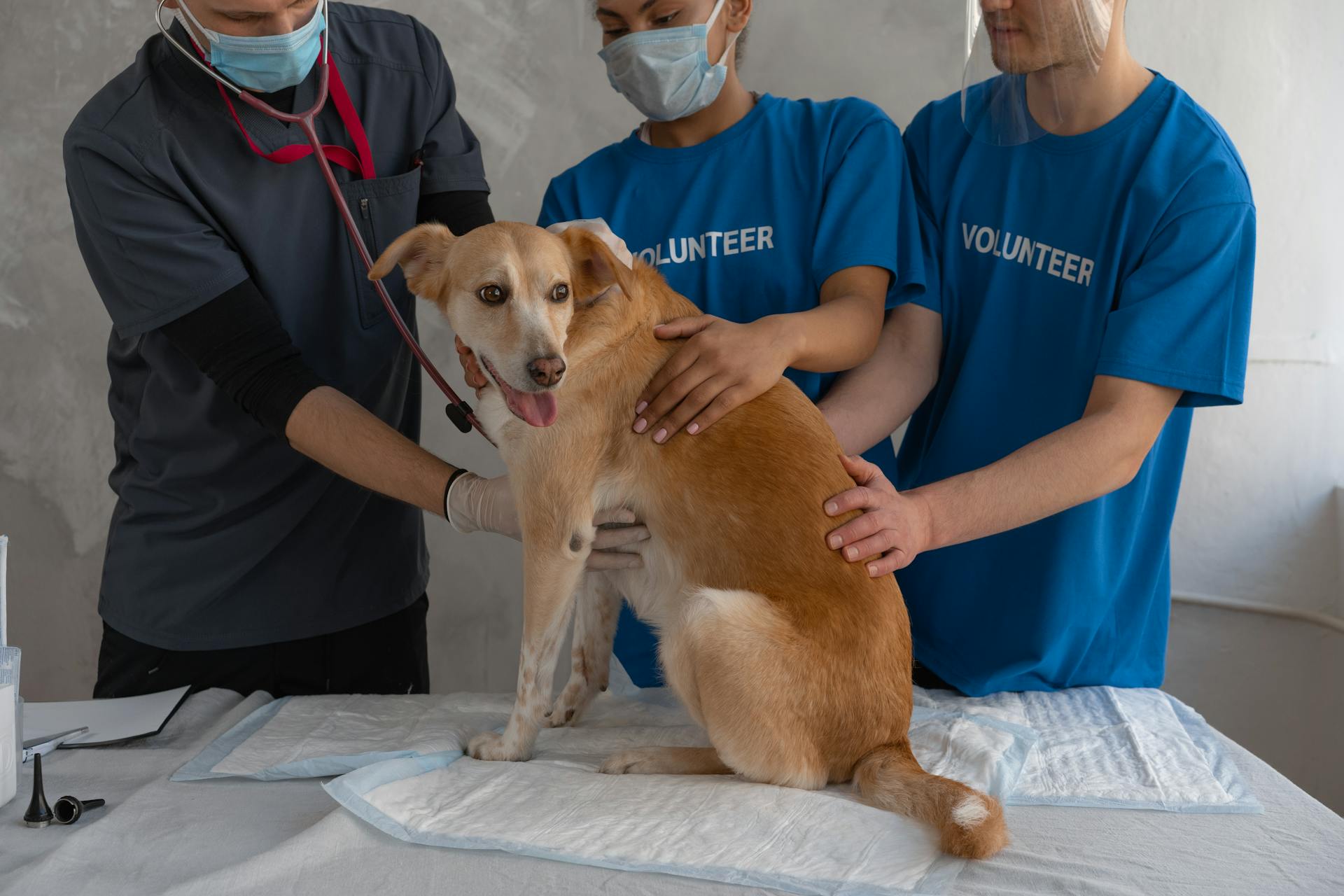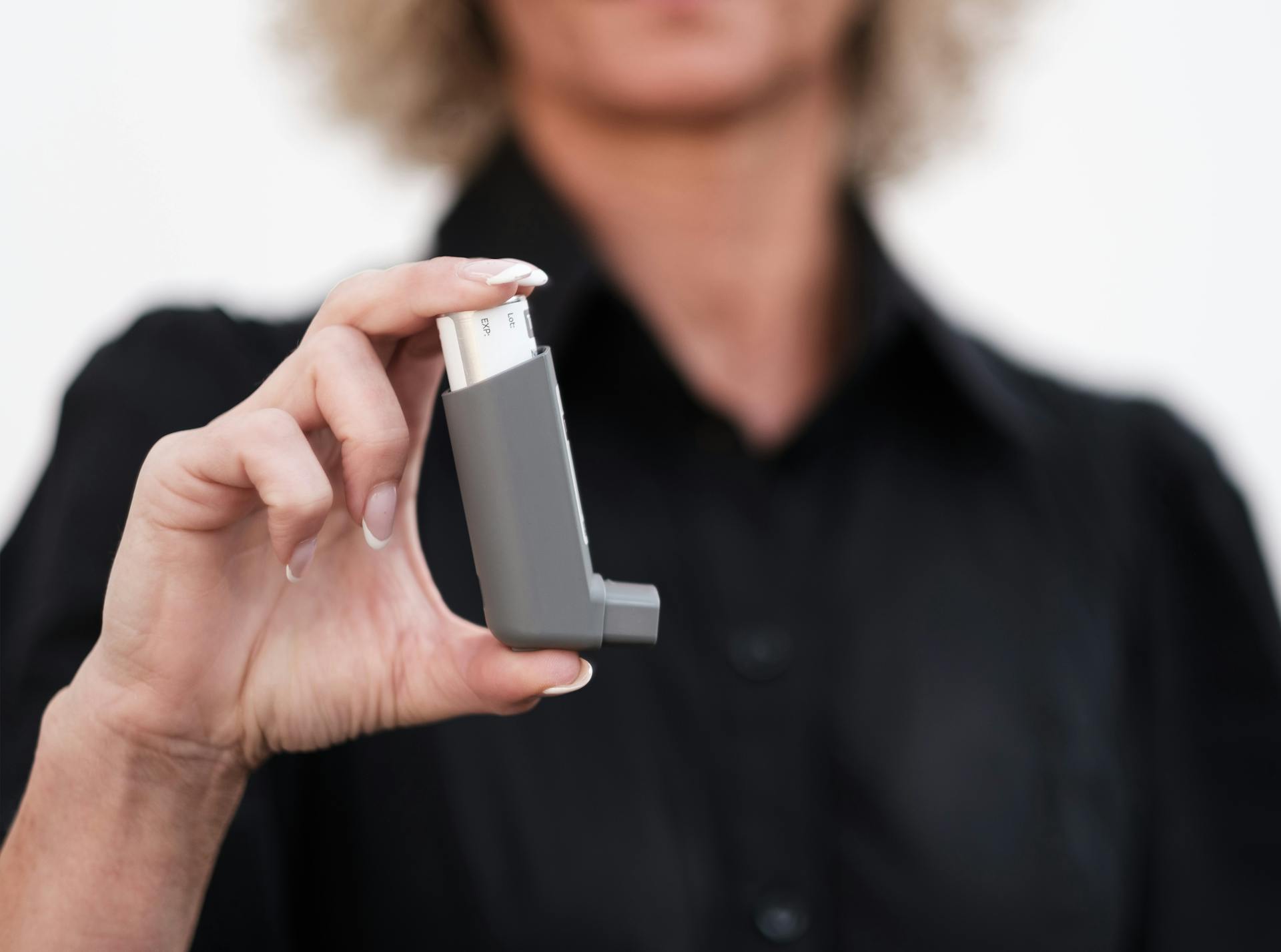
Asthma attacks in dogs can be unpredictable and alarming, but with the right knowledge, you can help your furry friend feel better.
Dogs with asthma may experience coughing, wheezing, or difficulty breathing due to inflammation and constriction of the airways.
Recognizing the signs of an asthma attack is crucial to provide prompt treatment.
Common symptoms include rapid breathing, panting, and a blue-tinged tongue or gums.
If you suspect your dog is having an asthma attack, stay calm and act quickly to prevent further complications.
Discover more: Asthma Attacks
What Is Asthma in Dogs?
Asthma in dogs is a chronic respiratory condition that affects the airways, causing inflammation, constriction, and difficulty breathing.
Dogs with asthma experience recurring episodes of coughing, wheezing, and shortness of breath, often triggered by allergens or irritants in the environment.
Asthma can be a life-threatening condition if left untreated or poorly managed, but with proper care and medication, many dogs can lead happy and healthy lives.
Worth a look: Cat Asthma Attack
Causes
Asthma in dogs can be caused by a combination of genetic and environmental factors.
Some breeds, such as West Highland White Terriers and Miniature Schnauzers, are more prone to developing asthma due to their genetic predisposition.
Allergies to inhaled substances like pollen, dust, and mold can trigger asthma symptoms in dogs.
Dogs exposed to cigarette smoke, pollution, and strong chemicals are more likely to develop asthma.
Inhaling strong odors, such as those from perfumes or cleaning products, can also trigger asthma attacks in dogs.
Definition
Asthma in dogs is a chronic respiratory disease that affects their airways, causing them to become inflamed and constricted, making it difficult for them to breathe.
The airways in dogs with asthma are like narrow, winding roads that become congested with excess mucus and debris, making it hard for air to pass through.
In severe cases, asthma in dogs can trigger a life-threatening condition called status asthmaticus, where the airways become completely blocked, requiring immediate veterinary attention.
Symptoms of asthma in dogs can vary, but common signs include coughing, wheezing, and difficulty breathing, especially after exercise or exposure to allergens.
Asthma in dogs is often caused by allergies, genetics, or environmental factors, such as exposure to pollen, dust, or mold.
Symptoms and Signs
If your dog is experiencing an asthma attack, there are several symptoms and signs to look out for.
The most common sign of an asthma attack in dogs is excessive panting, which can be a heavy, labored breathing even when your dog is at rest.
Panting is a normal behavior in dogs, but if it becomes excessive and persistent, it may be a sign of an asthma attack.
Dogs with asthma may also exhibit persistent coughing, loss of energy, and difficulty breathing.
These symptoms can be sudden and severe, and may be accompanied by rapid breathing, heavy panting with the mouth wide open, and wheezing.
Other signs of an asthma attack in dogs include bluish colored gums, caused by a lack of oxygen, and loss of appetite.
If your dog is experiencing any of these symptoms, it's essential to contact your vet immediately, as asthma may be the cause, but other serious conditions can also be to blame.
Here are some common symptoms of dog asthma:
- Persistent cough
- Loss of energy
- Difficulty breathing (often sudden)
- Rapid breathing
- Heavy panting with mouth wide open
- Wheezing
- Bluish colored gums
- Loss of appetite
Keep in mind that some breeds, such as Pugs and Bulldogs, may be more prone to breathing complications due to their small nasal openings.
Treatment and Management
Dog asthma attacks are an emergency that requires immediate attention. Your dog may be hospitalized and given oxygen to help them breathe better.
IV fluids may be administered if your dog hasn't eaten or drunk anything. Medicines that might be given include bronchodilators to open up the airways, antibiotics if an infection is present, and steroids to help reduce allergic reactions.
Asthma attacks can cause permanent damage to a dog's lungs, which is why symptoms should always be taken seriously. Contact your vet if you see any signs of an asthma attack.
Medications to treat dog asthma may include bronchodilators to help open up the airways, antihistamines to reduce allergic reactions, and steroids to decrease inflammation in the airways.
On a similar theme: What to Do If Neighbor's Dog Attacks You?
Treatment Options
Treatment for dog asthma depends on the severity of the disease and whether your dog is having an active attack or trying to prevent attacks.
Medications are the mainstay of treatment, and your veterinarian may prescribe bronchodilators, antihistamines, and steroids to open up airways, reduce allergic reactions, and decrease inflammation.

In severe cases, hospitalization and oxygen therapy may be necessary to help your dog breathe better.
A nebulizer can be used to deliver medication directly to the lungs, and some dogs can be trained to tolerate this treatment.
If your dog is having a mild attack, prescription pet medication can be given orally or through a nebulizer.
To determine the best treatment option for your dog, it's essential to work closely with your veterinarian to identify the underlying causes of the asthma and develop a treatment plan.
Here are some common medications used to treat dog asthma:
- Bronchodilators: aminophylline, terbutaline, or theophylline
- Steroids: prednisone, prednisolone, or dexamethasone
By following your veterinarian's recommendations and making some simple changes to your home environment, you can help manage your dog's asthma and improve their quality of life.
Some preventive measures you can take include:
- No smoking or vaping near the dog
- Utilize a HEPA air filter in your furnace, or utilize a room air purifier
- Wipe your dog off with baby wipes after going outside to remove allergens
- Don’t use your fireplace or burn wood near your dog
- Use dust-free cat litter if you have cats
- Remove carpets from the home and replace with hard flooring
- Wash pet bedding regularly
- Use dust- and mite-proof mattress covers and pillow cases
- Don’t burn incense or candles
Pet Insurance Coverage
Pet insurance can be a lifesaver for your furry friend, especially when it comes to chronic conditions like asthma. Complete Coverage includes illness coverage, which covers the costs of diagnosing and treating asthma.
Pet insurance plans often have an illness waiting period, so if your dog had symptoms before enrolling, asthma may not be covered. This is why it's essential to cover your pet sooner rather than later.
Reimbursing up to your annual limit each year can be a huge help if your dog needs ongoing treatment for asthma.
Prevention and Care
To prevent asthma attacks in dogs, minimize their exposure to allergens that might cause an attack. You can start by removing area rugs and replacing carpeting with other types of flooring, as they can hold in allergens like dust mites and mold.
Purchase a room air purifier to help remove particles in the air that can trigger an attack. This simple step can make a big difference in keeping your dog's air clean.
Bathing your dog regularly can also help reduce allergens on their coat. Choose a safe, unscented shampoo made for dogs and dry them off with a soft towel afterward.
Related reading: Heart Attack
If you have a cat, switch to dust-free cat litter to reduce the amount of allergens in your home. Place the litterbox in a spot where your dog can't get to it.
To keep your dog's bedding and blankets clean, wash them frequently using fragrance-free laundry detergents and fabric softeners. This will help reduce allergens that can trigger attacks.
Here are some common allergens to avoid in your home:
- Pollen
- Dust mites
- Mold
- Wood smoke
- Scented products
Wipe your dog off with pet-safe wipes after going outside to remove pollen and other allergens from their coat. This simple step can help prevent attacks.
Avoid using scented air fresheners or deodorizers, and instead place shallow bowls of baking soda around the house out of paw's reach to absorb odors.
Diagnosis and Emergency Response
Diagnosing asthma in dogs can be a bit tricky, especially if your dog doesn't have an attack in the vet's office. Your veterinarian will rely on your description of the symptoms and your dog's medical history to make a diagnosis.
They'll ask you about how and when the symptoms occurred, as well as any history of allergies or previous asthma attacks. Your veterinarian will also conduct a nose to tail physical exam to look for any signs of the condition.
Your veterinarian may order blood tests, urinary analysis, and chest X-rays to help rule out other illnesses, such as infections, kennel cough, or bronchitis. They may also test for heartworm disease since it can show similar symptoms to asthma.
If your dog is having a severe asthma attack, it's essential to stay calm and not panic. Dogs can pick up on our emotional states, and they may get more upset if they see that we're panicked.
Diagnosing Asthma
Diagnosing asthma in dogs can be a bit tricky because the symptoms might not always be obvious. Your veterinarian will rely on your description of the symptoms and your dog's medical history to make a diagnosis.
They'll ask you about how and when the symptoms occurred, as well as any history of allergies or previous asthma attacks. Your veterinarian will want to know if your dog has had any recent exposure to allergens or irritants that could trigger an asthma attack.
A nose to tail physical exam will be conducted to look for any signs of respiratory distress or other underlying conditions. Your veterinarian may also order blood tests, urinary analysis, and chest X-rays to help rule out other illnesses.
These diagnostic tools can help identify other potential causes of your dog's symptoms, such as an infection, kennel cough, or bronchitis. Heartworm disease is another condition that can show similar symptoms to asthma, so your veterinarian may test for it as well.
Emergency Response
Staying calm is crucial during an asthma attack. A panicked owner can make the situation worse for their dog.
You should try to calm your dog down by talking to them gently. This can help reduce their stress levels and make them more receptive to your care.
It's essential to call your veterinary clinic for advice as soon as possible. They can offer recommendations over the phone, including whether or not you should bring your dog in for immediate medical treatment.
Frequently Asked Questions
Can dogs trigger asthma attacks?
Yes, dogs can trigger asthma attacks in people with allergies due to their fur and dander, which can exacerbate respiratory issues. If you have asthma, consider learning more about pet allergies and how to manage them.
Sources
- https://petparentsbrand.com/blogs/health/can-dogs-have-asthma
- https://www.ovrs.com/blog/canine-respiratory-issues/
- https://www.lakecross.com/site/blog-huntersville-vet/2020/12/30/asthma-dogs-signs-symptoms-treatment-options
- https://www.aspcapetinsurance.com/resources/dog-asthma/
- https://www.petmd.com/dog/general-health/can-dogs-have-asthma
Featured Images: pexels.com


